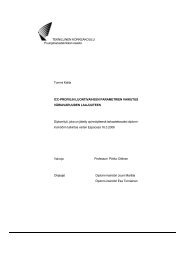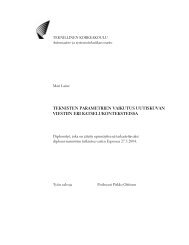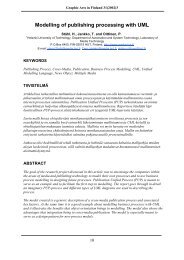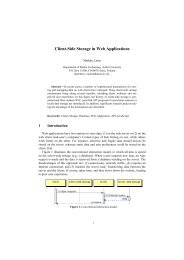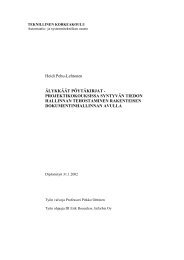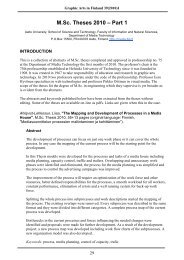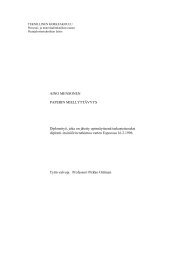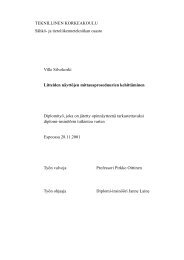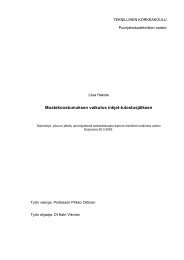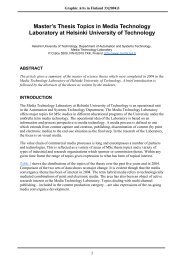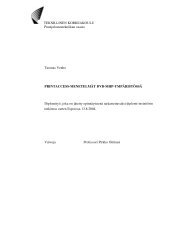Method for measuring stereo camera depth accuracy based ... - TKK
Method for measuring stereo camera depth accuracy based ... - TKK
Method for measuring stereo camera depth accuracy based ... - TKK
Create successful ePaper yourself
Turn your PDF publications into a flip-book with our unique Google optimized e-Paper software.
<strong>Method</strong> <strong>for</strong> <strong>measuring</strong> <strong>stereo</strong> <strong>camera</strong> <strong>depth</strong> <strong>accuracy</strong> <strong>based</strong> on<br />
<strong>stereo</strong>scopic vision<br />
Mikko Kytö*, Mikko Nuutinen, Pirkko Oittinen<br />
Aalto University School of Science and Technology, Department of Media Technology,<br />
Otaniementie 17, Espoo, Finland<br />
ABSTRACT<br />
We present a method to evaluate <strong>stereo</strong> <strong>camera</strong> <strong>depth</strong> <strong>accuracy</strong> in human centered applications. It enables the comparison<br />
between <strong>stereo</strong> <strong>camera</strong> <strong>depth</strong> resolution and human <strong>depth</strong> resolution. Our method uses a multilevel test target which can<br />
be easily assembled and used in various studies. Binocular disparity enables humans to perceive relative <strong>depth</strong>s<br />
accurately, making a multilevel test target applicable <strong>for</strong> evaluating the <strong>stereo</strong> <strong>camera</strong> <strong>depth</strong> <strong>accuracy</strong> when the <strong>accuracy</strong><br />
requirements come from <strong>stereo</strong>scopic vision.<br />
The method <strong>for</strong> <strong>measuring</strong> <strong>stereo</strong> <strong>camera</strong> <strong>depth</strong> <strong>accuracy</strong> was validated with a <strong>stereo</strong> <strong>camera</strong> built of two SLRs (singlelens<br />
reflex). The <strong>depth</strong> resolution of the SLRs was better than normal <strong>stereo</strong> acuity at all measured distances ranging<br />
from 0.7 m to 5.8 m. The method was used to evaluate the <strong>accuracy</strong> of a lower quality <strong>stereo</strong> <strong>camera</strong>. Two parameters,<br />
focal length and baseline, were varied. Focal length had a larger effect on <strong>stereo</strong> <strong>camera</strong>'s <strong>depth</strong> <strong>accuracy</strong> than baseline.<br />
The tests showed that normal <strong>stereo</strong> acuity was achieved only using a tele lens.<br />
However, a user's <strong>depth</strong> resolution in a video see-through system differs from direct naked eye viewing. The same test<br />
target was used to evaluate this by mixing the levels of the test target randomly and asking users to sort the levels<br />
according to their <strong>depth</strong>. The comparison between <strong>stereo</strong> <strong>camera</strong> <strong>depth</strong> resolution and perceived <strong>depth</strong> resolution was<br />
done by calculating maximum erroneous classification of levels.<br />
Keywords: Stereo <strong>camera</strong>, <strong>depth</strong> <strong>accuracy</strong>, <strong>depth</strong> resolution, <strong>stereo</strong> acuity, video see-through display<br />
1. INTRODUCTION<br />
Evaluating <strong>stereo</strong> <strong>camera</strong> <strong>depth</strong> <strong>accuracy</strong> is a non-trivial task. Depth <strong>accuracy</strong> is affected by multiple error sources<br />
including calibration and matching errors of correspondence points. Stereo <strong>camera</strong>s have been used widely <strong>for</strong> <strong>measuring</strong><br />
<strong>depth</strong> in photogrammetry and in remote sensing. In those areas the baselines (the distance between <strong>camera</strong>s) are very<br />
large and measures are taken mainly from static scenes. Human centered applications like augmented reality sets<br />
different <strong>accuracy</strong> requirements <strong>for</strong> <strong>stereo</strong> <strong>camera</strong>s. The <strong>stereo</strong> <strong>camera</strong> has short baseline and is usually wearable. Stereo<br />
<strong>camera</strong>s have to be fixed properly to prevent relative movements between the <strong>camera</strong>s and between the user and the<br />
<strong>camera</strong>s. Misalignment errors have to be traceable [1]. There is a need to examine the <strong>stereo</strong> <strong>camera</strong>’s <strong>accuracy</strong> in two<br />
ways (a) absolute <strong>depth</strong> measurement <strong>accuracy</strong> and (b) <strong>depth</strong> resolution. These properties should be investigated<br />
separately, so that characterization of a <strong>stereo</strong> <strong>camera</strong> and its error sources is possible.<br />
Standardized methods to evaluate the <strong>stereo</strong> <strong>camera</strong> <strong>depth</strong> <strong>accuracy</strong> don’t exist so far. Accuracy of a <strong>stereo</strong> <strong>camera</strong> is<br />
usually evaluated <strong>for</strong> example with human body [2] or objects like cars [3], so the dimensions of test 3D objects vary<br />
between studies. The aim of the study was to develop a method that could compare the measured and perceived <strong>depth</strong><br />
resolution. The comparison between visual resolution and measured spatial resolution can be done with ISO 12233<br />
resolution measurement standard <strong>for</strong> 2D images, but there doesn’t exist <strong>depth</strong> resolution standard <strong>for</strong> <strong>stereo</strong>scopic<br />
applications where the scene is measured and showed to user with same <strong>camera</strong>s.<br />
The method shown in this paper uses a modular test target which can be easily copied and used in various human<br />
centered applications in close range applications. For video see-through systems the human <strong>depth</strong> perception is usually<br />
investigated <strong>for</strong> absolute <strong>depth</strong>s from the user (egocentric approach) (see [4] <strong>for</strong> reference) but the method presented in<br />
this study can also be used to measure human <strong>depth</strong> resolution. For example applications related to construction and<br />
assembly would need this kind of approach where the relations of <strong>depth</strong>s of objects to each other are important.<br />
*mikko.kyto @tkk.fi; phone +358947023348; fax 1 222 555-876; http://media.tkk.fi/en/
Section 2 presents the basic concepts of human <strong>depth</strong> resolution and <strong>stereo</strong> <strong>camera</strong> <strong>depth</strong> resolution. The method <strong>for</strong><br />
<strong>measuring</strong> <strong>stereo</strong> <strong>camera</strong> <strong>depth</strong> resolution in practice is presented in Section 3. The effect of two principal variables of<br />
<strong>stereo</strong> <strong>camera</strong>s, baseline and focal length, were tested with the developed method. The results of baseline tests were<br />
compared to subjective evaluations. The results of these tests are presented in Section 5. Conclusion of this study is in<br />
Section 6.<br />
2.1 Human <strong>depth</strong> resolution<br />
2. DEPTH RESOLUTION<br />
Binocular disparity has the biggest <strong>depth</strong> sensitivity (later called <strong>depth</strong> resolution) of <strong>depth</strong> cues when the distance is less<br />
than 5 meters [5] (see Figure 1.). This means that binocular disparity sets the requirement <strong>for</strong> system’s <strong>depth</strong> resolution.<br />
Of course the monocular <strong>depth</strong> cues have also important role in sensing the <strong>depth</strong>s and should be noticed when defining<br />
the <strong>depth</strong> <strong>accuracy</strong> requirements. However, monocular <strong>depth</strong> cues depend on application specific issues so their<br />
influence on <strong>accuracy</strong> requirements should be evaluated in each separate case.<br />
dZ h<br />
Z<br />
Figure 1. Depth resolution from binocular disparity dZ h at distance Z. I is interpupillary distance, typically 6.5 cm.<br />
Human <strong>depth</strong> resolution dZ h from binocular disparity can be calculated with Equation 1 [6]:<br />
I<br />
Z 2 ∆T<br />
dZ<br />
h<br />
=<br />
(1)<br />
I<br />
where ∆T is the angular resolution of the human eye (<strong>stereo</strong> acuity), and <strong>for</strong> 80% of the population it’s below 30 arcsec<br />
(=0.008°)[7]. A widely used value is 20 arcsec [8]. Equation 1 applies to the <strong>depth</strong> difference of objects. So one cannot<br />
say that humans can judge a five meter absolute distance with a few centimeters <strong>accuracy</strong>. Instead, this <strong>depth</strong> difference<br />
between objects can be distinguished correctly.<br />
However the <strong>accuracy</strong> requirement from video see-through systems is different from direct naked eye viewing. In<br />
applications where the user operates <strong>based</strong> on <strong>stereo</strong> <strong>camera</strong> measurements it is not meaningful to measure the<br />
environment more accurately than humans can perceive. In <strong>stereo</strong>scopic video see-through systems the <strong>depth</strong> resolution<br />
[9] can be approximated with equation 2:<br />
Z 2 ∆T<br />
dZ<br />
st<br />
=<br />
(2)<br />
MNI<br />
where M is magnification (ratio of display FOV and <strong>camera</strong> FOV), N is the effective interpupillary distance (ratio of<br />
baseline and interpupillary distance).<br />
2.2 Stereo <strong>camera</strong> <strong>depth</strong> resolution<br />
Stereoscopic imaging geometry and quantization resolution set the limit <strong>for</strong> theoretical <strong>stereo</strong> <strong>camera</strong> <strong>depth</strong> resolution.<br />
The theoretical <strong>depth</strong> resolution of a <strong>stereo</strong> <strong>camera</strong> dZ c at the distance Z is calculated as [10]:<br />
2<br />
Z<br />
dZ<br />
c<br />
= dp x<br />
(3)<br />
fb<br />
where f is focal length, b is baseline and dp x is disparity <strong>accuracy</strong>. The schematic concept of <strong>depth</strong> resolution is shown in<br />
Figure 2.
Depth<br />
resolution<br />
Depth<br />
resolution<br />
f<br />
b<br />
a) b)<br />
Figure 2. The schematic representation of <strong>depth</strong> resolution with shorter baseline (a) and longer base (b).<br />
The <strong>stereo</strong> <strong>camera</strong> <strong>depth</strong> estimates are however affected by alignment and calibration errors of <strong>stereo</strong> <strong>camera</strong> parameters<br />
[1]. Disparity <strong>accuracy</strong> depends on the matching <strong>accuracy</strong> of the correspondence algorithm. For these reasons the<br />
equation 2 is not enough <strong>for</strong> evaluating the <strong>depth</strong> resolution of practical <strong>stereo</strong> <strong>camera</strong> measurement systems as we will<br />
see in the experimental part of this study.<br />
2.3 Theoretical comparison between <strong>camera</strong> and human<br />
In human centered applications <strong>for</strong> example in augmented reality the surrounding environment can be measured with<br />
<strong>stereo</strong> <strong>camera</strong>s to align the virtual objects to correct places and detect occlusions in the view [11]. To align the objects to<br />
the scene the <strong>stereo</strong> <strong>camera</strong> has to have a better <strong>depth</strong> resolution than the human <strong>depth</strong> resolution from the binocular<br />
disparity so that <strong>depth</strong> errors in the scene would not be noticed. This means that (dZ h > dZ c ), so we can use equations 1<br />
and 3, to find the limit <strong>for</strong> the <strong>depth</strong> <strong>accuracy</strong>:<br />
Z 2<br />
Z<br />
2 ∆ T<br />
≥ dp x<br />
(4)<br />
I fb<br />
By eliminating distance Z and arranging the equation 4 we get:<br />
dp<br />
x<br />
I<br />
fb > (5)<br />
∆T<br />
The larger the product focal length × baseline is, the more accurate <strong>depth</strong> measurements can be expected. On the other<br />
hand the product must be small to avoid occlusions and to limit disparity range because it increases the computation time<br />
of <strong>stereo</strong> correspondence algorithms. If the same <strong>camera</strong>s are used <strong>for</strong> <strong>measuring</strong> and showing the surrounding<br />
environment to the user, the ortho<strong>stereo</strong>scopic viewing conditions should be met. To achieve these conditions the<br />
baseline is set to the interpupillary distance [12] b = I and the requirement <strong>for</strong> the focal length can be written:<br />
dp<br />
x<br />
f ≥ (6)<br />
∆T<br />
The requirement <strong>for</strong> focal length (Equation 6) comes from <strong>depth</strong> <strong>accuracy</strong>. The other requirement to focal length comes<br />
from the human field-of-view (FOV). The common FOV <strong>for</strong> both eyes is about 120 degrees [8]. To achieve the same<br />
FOV with <strong>camera</strong> the requirement <strong>for</strong> focal length can be written:<br />
S w<br />
/ 2 S<br />
w<br />
f ≤ =<br />
(7)<br />
tan( 60°<br />
) 2 3<br />
where S W is width of sensor. To meet the requirement from <strong>accuracy</strong> (equation 6) and FOV (equation 7) we can set the<br />
focal length to be equal. This arrangement gives requirement <strong>for</strong> disparity <strong>accuracy</strong>:<br />
S<br />
w∆T<br />
dp<br />
x<br />
= (8)<br />
2 3<br />
For example with values, ∆T=20 arcsec, S w =6.4 mm, the disparity <strong>accuracy</strong> on the sensor should be 0.18 µm to achieve<br />
same <strong>depth</strong> resolution as humans have. For horizontal resolution of 1280 this means 0.1 pixel disparity <strong>accuracy</strong>. The<br />
focal length should be then 1.85 mm. In practice the accurate <strong>stereo</strong> <strong>camera</strong> with these parameters is still difficult task to<br />
achieve. For example lens distortions of a wide angle lens are difficult to compensate and alignment errors in roll, pitch,<br />
yaw and tilt are inversely proportional to baseline length [1]. With interpupillary distance these errors are remarkable.
3.1 Test target<br />
3. PRESENTING THE METHOD<br />
The requirements <strong>for</strong> the test target are derived from human <strong>depth</strong> resolution. The test target has to have levels at<br />
different distances related to each other. Moreover the target should support <strong>measuring</strong> the errors from <strong>stereo</strong> <strong>camera</strong><br />
calibration and misalignment. The test target should fulfill the requirements presented in Table 3.<br />
Table 3. Requirements from <strong>stereo</strong>scopic vision and <strong>stereo</strong> <strong>camera</strong> <strong>depth</strong> measurement <strong>accuracy</strong><br />
Requirements from<br />
<strong>stereo</strong>scopic vision<br />
− Levels at different <strong>depth</strong>s<br />
− Modular test target: the<br />
distances between levels can be<br />
adjusted<br />
− The levels of the test target can<br />
be mixed randomly to test <strong>depth</strong><br />
resolution<br />
− Minimal or no monocular <strong>depth</strong><br />
cues<br />
Requirements from <strong>stereo</strong> <strong>camera</strong> <strong>depth</strong> measurement<br />
<strong>accuracy</strong><br />
− The relative movements and rotations of the <strong>camera</strong>s have to be<br />
observed from the measurements: there has to be <strong>measuring</strong> points in<br />
both sides of the <strong>stereo</strong> rig’s x- and y-axis to notice errors in<br />
calibration and alignment.<br />
− Geometrically well-known and simple: this enables comparison of<br />
<strong>stereo</strong> correspondence algorithms to ground truth <strong>depth</strong> maps.<br />
− Accurate <strong>depth</strong> measurements are possible: possibility to achieve<br />
subpixel disparity <strong>accuracy</strong><br />
− No occlusion problems: all <strong>depth</strong> <strong>measuring</strong> points have to be seen<br />
by both <strong>camera</strong>s<br />
− High precision: enough <strong>measuring</strong> points<br />
The test target (see Figure 3a) <strong>for</strong> this study was built of pieces with different thicknesses of levels by mounting them on<br />
a planar surface (500 mm x 500 mm). The Figure 3b shows test target used in perceptual evaluations. It is otherwise<br />
same as in Figure 3a, but the patches of levels are changed to white vertical bars. White vertical bars were chosen,<br />
because the disparity can be easily detected from vertical lines with high contrast. The levels of the target can mixed<br />
randomly to and test participants are asked to arrange them in the right order according to level height to enable the<br />
evaluation of perceived <strong>depth</strong> resolution. The Howard-Dolman <strong>stereo</strong> test [13] could also be used to evaluate the<br />
perceived <strong>depth</strong> resolution in video see-through systems, but it is not suitable <strong>for</strong> testing the <strong>stereo</strong> <strong>camera</strong> <strong>depth</strong><br />
resolution due to small amount of possible <strong>measuring</strong> points from the movable rods.<br />
The thickness of the levels can be adjusted <strong>based</strong> on <strong>depth</strong> resolution requirements of the applications of interest. The<br />
more accurate the <strong>stereo</strong> <strong>camera</strong> or the closer working range the smaller <strong>depth</strong> differences between the levels can be<br />
used. The constructed test target allows mounting of pieces of eight different thicknesses. The heights of the levels were<br />
206, 150, 93, 75, 54, 35, 17 and 6 mm (measured with <strong>measuring</strong> tape from the zero level, error ±1 mm).<br />
One of the proposed test target’s pros against planar surface is that it is not dependent on very accurate ground truth<strong>measuring</strong><br />
between <strong>camera</strong>’s focal point and target. It doesn’t matter if the absolute <strong>measuring</strong> distance to the test target<br />
is 1999 mm or 2000 mm, because the measurements are relative to the zero level. Another option would be that distance<br />
from planar test target to the <strong>stereo</strong> <strong>camera</strong> is changed a little and test if the <strong>camera</strong> has measured this movement.<br />
However, that is much slower because one should take measurements from many distances to achieve same data as with<br />
the test target with one <strong>measuring</strong> distance.<br />
(a) (b) (c) (d)<br />
Figure 3. The test target <strong>for</strong> a) <strong>stereo</strong> <strong>camera</strong> measurements b) perceptual tests. “Near” ground truth <strong>depth</strong> map from corner<br />
extraction (d) <strong>depth</strong> map from correspondence algorithm. Levels (1-8) are at different distances from the zero level (9).<br />
In the middle there are alignment points <strong>for</strong> different baselines.
3.2 Matching<br />
The <strong>measuring</strong> points from the test target were selected using Camera Calibration Toolbox <strong>for</strong> Matlab [16]. It uses Harris<br />
corner finder function [14] which can find corners with 0.1 pixel <strong>accuracy</strong>. The “near” ground truth disparity map can be<br />
constructed by interpolating the disparities between selected <strong>measuring</strong> points from corner extraction (See figure 3c and<br />
4). The “near” ground truth disparity map can be compared to <strong>accuracy</strong> of <strong>stereo</strong> correspondence algorithms (See figure<br />
3d). Figure 3d shows an example of absolute pixel error of <strong>stereo</strong> correspondence algorithm with SAD (sum of absolute<br />
difference) found in [15]. This is how you can separate the <strong>accuracy</strong> of calibration from <strong>accuracy</strong> of correspondence<br />
algorithms. Different textures instead of a checkerboard pattern can be used to evaluate the <strong>accuracy</strong> of the<br />
correspondence algorithms as in [15].<br />
3.3 Measures<br />
Figure 4. Disparity map generated by interpolating between corner points.<br />
The proposed measure <strong>for</strong> <strong>depth</strong> resolution is <strong>based</strong> on the levels to enable the comparison between the human and<br />
<strong>camera</strong>. In principle both, <strong>camera</strong> and human are asked to order the levels to right order according level height. The<br />
biggest erroneous classification of the levels is used to measure <strong>depth</strong> resolution. The <strong>depth</strong> resolution is given as the<br />
maximum real distance between erroneously classified levels. This measure gives possibility to compare the perceived<br />
<strong>depth</strong> resolution to <strong>stereo</strong> <strong>camera</strong> <strong>depth</strong> resolution. This measure is <strong>based</strong> on the fact that humans perceive <strong>depth</strong>s<br />
relatively to other objects with binocular disparity. This measure assures that if the measured erroneous classification<br />
with <strong>stereo</strong> <strong>camera</strong> is smaller than the perceived <strong>depth</strong> resolution then human would not see the <strong>depth</strong> errors in the scene.<br />
Figure 5a shows an example how to evaluate the perceived <strong>depth</strong> resolution in video see-through system (∆Z st ) from<br />
participants answer. The participant has made a mistake between levels 4 and 6 (level 4 has been evaluated to be lower<br />
than level 6) and the <strong>depth</strong> resolution is defined as difference between actual heights.<br />
Figure 5b shows an example of <strong>stereo</strong> <strong>camera</strong> <strong>depth</strong> resolution (∆Z c ).The <strong>stereo</strong> <strong>camera</strong> has sorted levels 6 and 8 to<br />
wrong order. The <strong>depth</strong> resolution is the difference between actual heights of levels 6 and 8. The line in Figure 5b is<br />
fitted using simple linear regression. Points are average <strong>depth</strong>s and error bar is standard deviation of <strong>depth</strong><br />
measurements. R is correlation coefficient and k is slope. R and k show how well the measured heights follow the actual<br />
heights of the test target (optimally both are one). Constant b is the measured absolute <strong>depth</strong> error from focal point to<br />
zero level, b = Z true - Z measured . For example if b < 0 then <strong>stereo</strong> <strong>camera</strong> has measured the test target’s zero level further<br />
than true value.<br />
Level number 1 2 3 4 5 6 7 8<br />
Participant’s answer 1 2 3 5 6 4 8 7<br />
Actual height (mm) 206 150 93 75 54 35 17 6<br />
∆Z st =<br />
75 mm – 35 mm =<br />
40 mm<br />
-100<br />
0 50 100 150 200<br />
Actual height (mm)<br />
(a)<br />
∆Z c<br />
(b)<br />
Figure 5. Example of a) perceived <strong>depth</strong> resolution (∆Z st ) and b) measured <strong>depth</strong> resolution (∆Z c )<br />
Measured height(mm)<br />
100<br />
50<br />
0<br />
-50<br />
Z = 2500mm, k = 0.938<br />
b = -77.415, R =0.983
The test target enables calculation of different traditional <strong>depth</strong> measures <strong>for</strong> every level. These are average <strong>depth</strong> and its<br />
standard deviation, median <strong>depth</strong>, maximum <strong>depth</strong>, minimum <strong>depth</strong> and <strong>depth</strong> histogram [3]. Also error measures like<br />
RMSE-error can be used.<br />
3.4 Validation of the calibration and <strong>stereo</strong> measurements<br />
The method was validated with two SLRs to show that accurate measurements can be achieved. Two Canon 400D KIT<br />
18-55 mm f/4.5-f/5.6 <strong>camera</strong>s were used. The focal length was 18 mm (corresponding to the horizontal field of view<br />
62°), aperture f/10 and the <strong>camera</strong>s were focused manually to infinity. The baseline was 14 cm. The pictures were taken<br />
in raw-<strong>for</strong>mat and trans<strong>for</strong>med to high quality jpeg –<strong>for</strong>mat. The <strong>camera</strong>s were calibrated with Camera calibration<br />
toolbox <strong>for</strong> Matlab [16] with 16 images of calibration pattern. The pattern consisted of a 31 x 22 checker board pattern.<br />
After calibration of the <strong>stereo</strong> <strong>camera</strong> the measurements were made at different distances from the zero level. Figure 6<br />
shows some examples of measurements between 0.7 m – 5.0 m.<br />
Measured Height (mm)<br />
200<br />
100<br />
Figure 6. Here is shown examples of validation measurements at three distances (742 mm , 3415 mm and 5000 mm).<br />
It is evident from Figure 6 that the measurements follow quite well the actual values. Correlation R > 0.99 <strong>for</strong> every<br />
measurement and the slope is between 0.97 < k < 1.01 <strong>for</strong> every measurement. Also <strong>depth</strong> resolution was measured. At<br />
all the distances the <strong>depth</strong> resolution was better than the binocular disparity <strong>accuracy</strong>. All the levels were classified to the<br />
right order so subpixel disparity <strong>accuracy</strong> was achieved. The method seems to give results accurate enough to be used in<br />
testing lower quality <strong>camera</strong> pairs.<br />
4.1 Measurements with <strong>camera</strong> modules<br />
4. USING THE METHOD<br />
Depth resolution is theoretically affected by focal length and baseline (Equation 3). Both were varied to test their effect<br />
on <strong>depth</strong> resolution in practice with lower quality <strong>stereo</strong> <strong>camera</strong>s. The <strong>stereo</strong> <strong>camera</strong> was built of two board <strong>camera</strong>s<br />
(Videology 24B1.3XUSB-C). The <strong>camera</strong>s are small (about 30 mm <strong>for</strong> every dimension) and can be worn on head.<br />
Three different lenses: wide-angle, normal and tele lens were used. Their focal length values were 3, 6 and 12 mm<br />
corresponding to horizontal FOVs 95°, 57° and 28°. The board <strong>camera</strong>s were mounted on a bar, which allowed changing<br />
the baseline between values 7, 14 and 21 cm. The 7 cm baseline represents the interpupillary distance and 14 cm the<br />
width of head. The value 21 cm is investigated to find whether it offers some extra benefit. Resolution of the images was<br />
1280 × 1024.<br />
The measurements were made at different distances ranging from 0.7 m to 5.8 m. The illumination was 1000 lx and the<br />
<strong>camera</strong>s were controlled by a laptop so that the exposure time and gain were kept constant. The calibration and<br />
<strong>measuring</strong> points were selected as in the validation tests.<br />
4.2 Perceptual evaluations<br />
Z = 742mm, k = 0.993<br />
b = 17.951, R =0.997<br />
0<br />
0 100 200<br />
Actual Height (mm)<br />
Measured height(mm)<br />
200<br />
150<br />
100<br />
50<br />
Z = 3415mm, k = 1.008<br />
b = 3.109, R =0.999<br />
0<br />
0 100 200<br />
Actual height (mm)<br />
0 100 200<br />
Actual height(mm)<br />
The images were taken of test target (Figure 3b) with same board <strong>camera</strong>s and in same lighting conditions as with <strong>stereo</strong><br />
<strong>camera</strong> measurements. Focal length was 6 mm and baseline was varied between values 7, 14 and 21 cm. The images<br />
were taken between 2 m - 6 m with one meter interval. The order of the levels was mixed using Latin square method<br />
between shots. Eight participants attended to tests (One female, ages between 22-26 years). All participants had normal<br />
or corrected to normal vision, and <strong>stereo</strong> acuity below 120 arc sec. One participant was excluded from the test. The<br />
Measured height(mm)<br />
250<br />
200<br />
150<br />
100<br />
50<br />
Z = 5000mm, k = 0.971<br />
b = 27.998, R =0.998
<strong>stereo</strong>scopic images were viewed with eMagin Z800 <strong>stereo</strong>scopic HMD (horizontal FOV 32° and resolution 800 x 600).<br />
The participants were asked to order the levels according to level height.<br />
5.1 Focal length<br />
5. RESULTS<br />
The focal length affected the <strong>depth</strong> resolution remarkably and shows that the equation 3 was not enough <strong>for</strong> evaluating<br />
the <strong>accuracy</strong> of practical <strong>stereo</strong> <strong>camera</strong> <strong>depth</strong> estimates The <strong>depth</strong> resolution with different focal lengths is shown in<br />
Figure 7. With wide angle-lens (f=3 mm) the <strong>depth</strong> resolution deteriorated at 4 meters distance to the maximum value<br />
(Figure 7a) The errors with wide angle lens were so big that <strong>measuring</strong> wasn’t continued with longer distances. The<br />
theoretical <strong>camera</strong> <strong>depth</strong> resolution (Camera theoretical) is computed with 0.1 pixel disparity <strong>accuracy</strong> (Equation 3), but<br />
because of the calibration errors the <strong>depth</strong> resolution has deteriorated.<br />
With normal lens (f=6 mm) the <strong>depth</strong> resolution was improved so that it gets nearer to human theoretical <strong>depth</strong><br />
resolution (Figure 7b). It can be seen that with only the tele lens (f=12 mm) the <strong>depth</strong> resolution is better than the<br />
theoretical human <strong>depth</strong> resolution at all measured distances between 0.7m - 5.8m (Figure 7c). The more accurate<br />
analysis of the measurements with 12 mm lens would require readjustments of the test target’s levels, as the smallest<br />
<strong>depth</strong> difference between levels was now 6 mm. The difference between levels can be decreased to test more accurate<br />
<strong>stereo</strong> <strong>camera</strong>; these distances between levels were used to show differences between <strong>camera</strong> setups.<br />
f=3 mm, b=14 cm<br />
f=6 mm, b=14 cm<br />
f=12 mm, b=14 cm<br />
200<br />
200<br />
200<br />
Depth resolution (mm)<br />
150<br />
100<br />
50<br />
150<br />
100<br />
50<br />
150<br />
100<br />
50<br />
∆Z c<br />
: Camera<br />
dZ c<br />
: Camera (Theoretical)<br />
dZ h<br />
: Human (Theoretical)<br />
0<br />
0<br />
0<br />
1 2 3 4 5 6 1 2 3 4 5 6<br />
Distance (m)<br />
Distance (m)<br />
(a) (b) (c)<br />
Figure 7. The <strong>depth</strong> resolution with a) wide angle-lens, b) normal lens c) wide angle-lens.<br />
5.2 Comparison to perceived <strong>depth</strong> resolution<br />
1 2 3 4 5 6<br />
Distance (m)<br />
In this test the <strong>stereo</strong> <strong>camera</strong> <strong>depth</strong> resolution was compared to perceived <strong>depth</strong> resolution by varying baseline and<br />
distance. The results show (Figure 8) that increasing the baseline improves the <strong>depth</strong> resolution on average. The<br />
theoretical <strong>stereo</strong> <strong>camera</strong> <strong>depth</strong> resolution nor theoretical human <strong>depth</strong> resolution were not achieved after two meters<br />
distance with this calibration <strong>accuracy</strong>.<br />
f=6 mm, b=7 cm<br />
f=6 mm, b=14 cm<br />
f=6 mm, b=21 cm<br />
200<br />
200<br />
200<br />
Depth resolution (mm)<br />
150<br />
100<br />
50<br />
150<br />
100<br />
50<br />
150<br />
100<br />
50<br />
∆Z c<br />
: Camera<br />
dZ c<br />
: Camera (Theoretical)<br />
∆Z h<br />
: Perceived<br />
dZ st<br />
: Perceived (Theoretical)<br />
0<br />
0<br />
0<br />
1 2 3 4 5 6 1 2 3 4 5 6 1 2 3 4 5 6<br />
Distance (m)<br />
Distance (m)<br />
Distance (m)<br />
(a) (b) (c)<br />
Figure 8. Camera and human <strong>depth</strong> resolution with different baselines. a) b = 7 cm b) b = 14 cm and c) b = 21 cm
It can be seen that the perceived <strong>depth</strong> resolution is deteriorated from theoretical value in the video see-through system<br />
with all baselines (the error bars are standard deviations). The longer baseline didn’t improve much the perceived <strong>depth</strong><br />
resolution on average.<br />
The deterioration from theoretical <strong>depth</strong> resolution means that the <strong>stereo</strong> <strong>camera</strong> <strong>depth</strong> resolution doesn’t have to meet<br />
the <strong>accuracy</strong> requirements from theoretical perceived <strong>depth</strong> resolution (Equation 2). Equation 2 gives only a rough<br />
estimate of actual <strong>depth</strong> resolution. Predicting the actual perceived <strong>depth</strong> resolution of <strong>stereo</strong>scopic video see-through<br />
system with more detailed model would be important. For example spatial resolution of <strong>camera</strong> and display and<br />
brightness of the display have an effect to <strong>depth</strong> resolution. This more detailed model could set the <strong>depth</strong> resolution<br />
requirements <strong>for</strong> <strong>stereo</strong> <strong>camera</strong> system. As said in human centered applications there is no point to measure the <strong>depth</strong>s of<br />
surrounding scene more accurately than the user can perceive.<br />
6. CONCLUSION<br />
The method shown enables the comparison the measured and perceived <strong>depth</strong> resolution of <strong>stereo</strong>scopic systems. The<br />
<strong>stereo</strong> <strong>camera</strong> <strong>depth</strong> resolution can be compared to video-see through <strong>depth</strong> resolution. Depth resolution was determined<br />
with a multi-level test target. The test target is useful <strong>for</strong> practical testing of <strong>depth</strong> resolution of <strong>stereo</strong> <strong>camera</strong>s up to<br />
several meters distances.<br />
The method showed differences between <strong>stereo</strong> <strong>camera</strong> setups. Two <strong>stereo</strong> <strong>camera</strong> parameters, focal length and baseline,<br />
influence to <strong>depth</strong> resolution was tested. Focal length and baseline have the same theoretical influence on <strong>depth</strong><br />
resolution, but the focal length had bigger influence in practice due to more accurate calibration in this study. The<br />
theoretical human <strong>depth</strong> resolution was achieved with SLRs and lower quality <strong>camera</strong>s with tele lens. This gives<br />
guidelines <strong>for</strong> the focal length and baseline selection depending on application <strong>depth</strong> <strong>accuracy</strong> requirements.<br />
The perceived <strong>depth</strong> resolution was deteriorated in video see-through system compared to theoretical <strong>depth</strong> resolution. In<br />
human centered applications the <strong>stereo</strong> <strong>camera</strong> <strong>depth</strong> resolution requirements should be derived from perceived <strong>depth</strong><br />
resolution. The more accurate model <strong>for</strong> perceived <strong>depth</strong> resolution in video see-through system should be obtained.<br />
ACKNOWLEDGEMENTS<br />
This research was part of UI-ART (Urban contextual in<strong>for</strong>mation interfaces with multimodal augmented reality) –<br />
project. Project belongs to MIDE (Multidisciplinary Institute of Digitalization and Energy) programme. The purpose of<br />
the programme is to bring together the expertise of various fields of engineering around shared research and application<br />
issues in order to promote the exploitation of ICT in generating new thinking in all fields of technology.<br />
http://mide.tkk.fi/en/<br />
REFERENCES<br />
[1] Zhao, W. and Nandhakumar, N. "Effects of <strong>camera</strong> alignment errors on <strong>stereo</strong>scopic <strong>depth</strong> estimates,"<br />
Pattern Recognition 29 (12), 2115-2126 (1996).<br />
[2] Kanade, T. et al., "A <strong>stereo</strong> machine <strong>for</strong> video-rate dense <strong>depth</strong> mapping and its new applications," IEEE<br />
Computer Society Conference on Computer Vision and Pattern Recognition, 196-202 (1996).<br />
[3] Bansal, M. et al., "Towards a Practical Stereo Vision Sensor," IEEE Computer Society Conference on<br />
Computer Vision and Pattern Recognition, 63-69 (2005).<br />
[4] Swan, J. E. et al., "A Perceptual Matching Technique <strong>for</strong> Depth Judgments in Optical, See-Through<br />
Augmented Reality," Virtual Reality Conference, 19-26 (2006).<br />
[5] Nagata, S. "How to rein<strong>for</strong>ce perception of <strong>depth</strong> in single two-dimensional pictures," [Pictorial<br />
Communication in virtual and real environments], Ellis, S., Taylor & Francis, 527-544 (1991).
[6] Harris, J.M. "Monocular zones in <strong>stereo</strong>scopic scenes: A useful source of in<strong>for</strong>mation <strong>for</strong> human binocular<br />
vision?," Proc. SPIE 7524, (2010).<br />
[7] Coutant, B. E. and Westheimer G., "Population distribution of <strong>stereo</strong>scopic ability," Ophthalmic and<br />
Physiological Optics 13(1), 3-7 (1993).<br />
[8] Çöltekin, A., "Foveation <strong>for</strong> 3D Visualization and Stereo Imaging.", Dissertation. (2006) Available:<br />
http://lib.tkk.fi/Diss/2006/isbn9512280175/isbn9512280175.pdf<br />
[9] Jennings, J. and Charman, N., "Depth resolution in <strong>stereo</strong>scopic systems," Applied optics 33(22), 5192-<br />
5196 (1994).<br />
[10] Chang, C. and Chatterjee S., "Quantization error analysis in <strong>stereo</strong> vision," Conference Record of The<br />
Twenty-Sixth Asilomar Conference on Signals, Systems and Computers 2, 1037-1041 (1992).<br />
[11] Schmidt, J., Niemann H. and Vogt S., "Dense disparity maps in real-time with an application to augmented<br />
reality," IEEE Workshop on Applications of Computer Vision, 225 - 230 (2002).<br />
[12] Takagi, A. et al., "Development of a <strong>stereo</strong> video seethrough HMD <strong>for</strong> AR systems," ISAR, 68-77 (2000).<br />
[13] Howard, H. J., "A test <strong>for</strong> the judgment of distance," Transactions of the American Ophthalmological<br />
Society 17, 195-235 (1919).<br />
[14] Harris, C., and Stephens M., "A combined corner and edge detector," Alvey vision conference 15, 147-151<br />
(1988).<br />
[15] Scharstein, D. and Szeliski R., "A taxonomy and evaluation of dense two-frame <strong>stereo</strong> correspondence<br />
algorithms," International journal of computer vision 47(1), 7-42 (2002).<br />
[16] Bouget, J., "Camera Calibration Toolbox <strong>for</strong> Matlab," 06-Feb-2008. [Online]. Available:<br />
http://www.vision.caltech.edu/bouguetj/calib_doc/. [Accessed: 15-Sep-2008].



